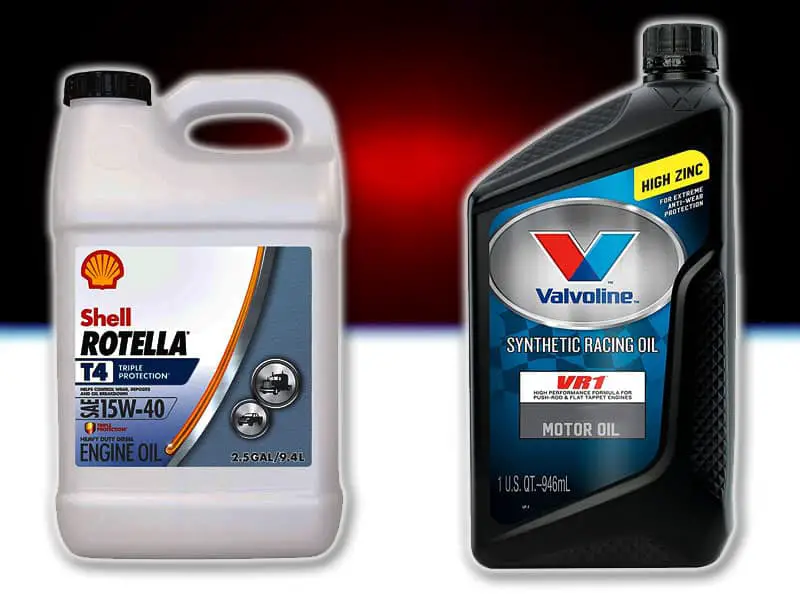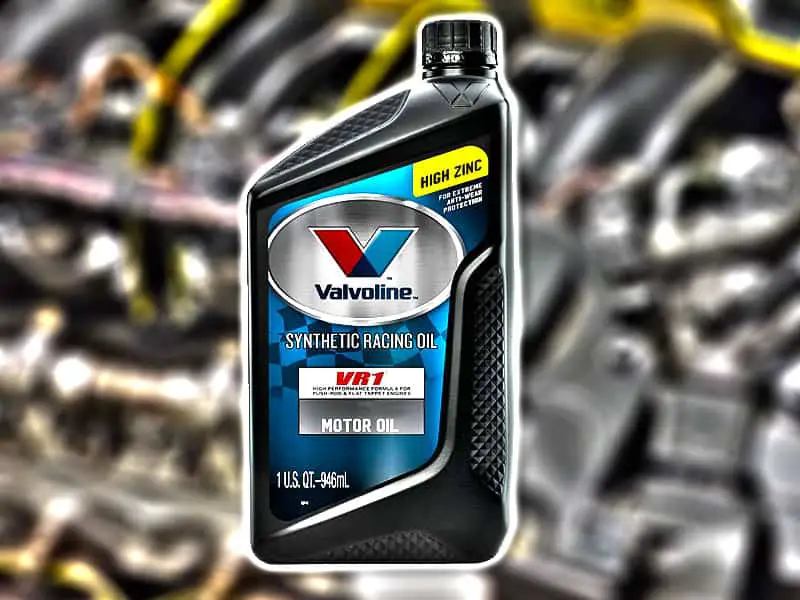Shell Rotella T4 is a synthetic blend oil utilized in both gasoline and diesel engines. Valvoline VR1 is a fully synthetic oil used in gasoline engines only. T4 focuses on anti-wearing while VR1 distinction is its performance in cold conditions.
Shell Rotella T4 contains a large number of calcium compounds as detergents for sludge clean-up. Its high flashpoint allows more protection against the problem of early burn-off. This oil also provides more resistance against engine wearing. The performance of T4 at medium, as well as high temperatures, is also quite superior. The higher TBN allows a lower frequency of oil change, providing better fuel economy.

Check out Detailed Comparison: Rotella T4 vs T5 vs T6

Valvoline VR1, on the other side, is more catalytic converter friendly due to lower ZDDP ash formation. This oil is also very useful in lower temperature conditions. It also contains a decent amount of both calcium and magnesium detergents to remove the sludge. Anti-foaming agents present in the oil also allow low foam build-up. Anti-wearing additives are also present in medium concentration to minimize engine wearing. High viscosity index of this oil also assists it to provide more stable viscosity at high temperatures.

Table of Contents
Shell Rotella T4 vs Valvoline VR1:
| Specifications | Shell Rotella T4 (10W-30) | Valvoline VR1 (10W-30) |
| Oil Type | Synthetic Blend | Fully Synthetic |
| Engine Type | Gasoline/ Diesel | Gasoline |
| Available viscosity grades | 10W-30, 15W-40 | 10W-30, 20W-50 |
| API | CK-4, CJ-4, CI-4 PLUS, CI-4, CH-4 | SM |
| Oil change frequency (miles) | 5,000 | 3000-4000 |
| Additives | Anti-wears, Detergents, Dispersants, Anti-oxidants | Anti-foaming agents, Anti-wear, Friction Modifiers |
| ACEA | E9 | A3/B4 |
Viscosity Comparison
Kinematic viscosity is described as the hindrance in the flow of fluid. Higher this kinematic viscosity better will be the performance of oil at high temperatures. The viscosity index indicates variations in the viscosity of a fluid as the temperature fluctuates.
This viscosity index needed to be high to experience a low change in the oil’s viscosity as the temperature rises. Pour point is the lowest temperature above which oil loses its flowing property.
The kinematic viscosity of Shell Rotella T4 is high at both medium temperature (40 o C) as well as high temperature (100 o C). However, Valvoline VR1 has a faintly higher viscosity index since it experiences relatively lower viscosity variations compared to its peer.
The performance of T4 in colder situations is better because of its lower pour point temperature.
| Oils in Comparison (10W-30 Grade oils) | Kinematic Viscosity @ 40 o C (cSt) | Kinematic Viscosity @ 100 o C (cSt) | Viscosity index (VI) | Pour point (Degrees Celsius) |
| Shell Rotella T4 | 81.8 | 12.1 | 141 | -43 |
| Valvoline VR1 | 68 | 10.7 | 146 | -33 |
Oil Change Frequency Comparison
During the combustion process, harmful acids are produced. These acids are harmful and dangerous for the engine. To overcome this issue, base additives (usually KOH) are added to the oil to neutralize these acids. Total Base Number (TBN) determines the concentration of these bases.
The concentration of these additives (TBN) decreases over time. The oil needs to be replaced if this TBN value decreases below a certain point (<1). Greater TBN results in a lower frequency of oil change.
Shell Rotella T4 has a higher TBN than its counterpart and needs to be changed after the average distance of 5000 miles. On the other hand, Valvoline VR1 provides an oil-changing frequency between 3000-4000 miles due to its relatively lower TBN.
Therefore, T4 provides a longer periods of oil change thus, providing better fuel economy.
| Oils in Comparison (10W-30 Grade oils) | TBN (Total Base Number) mg KOH/g |
| Shell Rotella T4 | 8.96 |
| Valvoline VR1 | 8.1 |
Catalytic Converter Performance Comparison
Zinc and phosphorus compounds added as anti-wear additives get converted into ash as engine oil burns. This ash is toxic and enters the catalytic converter and poisons it. This inhibits the performance of catalytic converter.
The amount of zinc and phosphorus is extremely high in Shell Rotella T4 while in comparison Valvoline VR1 has a low concentration of both these compounds. As a result, the formation of ash will be lower in VR1, so, its catalytic converter performance is better than its counterpart.
| Oils in Comparison (10W-30 Grade oils) | Zinc Concentration (ppm) | Phosphorus Concentration (ppm) |
| Shell Rotella T4 | 1310 | 1174 |
| Valvoline VR1 | 1080 | 941 |
Sludge Build-up Reduction Comparison
A black viscous liquid known as sludge is formed when the oxidized oil gets in contact with dirt, moisture, or any other impurity. Detergents and dispersants are added as additives to minimize this problem.
T4 has calcium-based detergents in abundance. Magnesium compounds are also present in the oil in good numbers. Small traces of silicon are also present to minimize the problem of foam build-up. Overall, it is superior to its counterpart in terms of cleaning the sludge.
Just like its competitor, Valvoline VR1 also consists mainly of magnesium and calcium-based detergents. The magnesium concentration of VR1 is higher than its rival. Both the oils contain same amount of sodium compounds. However, silicon which is used as an anti-foaming agent is present in a higher quantity.
| Oils in Comparison (10W-30 Grade oils) | Sodium Concentration (ppm) | Magnesium Concentration (ppm) | Calcium Concentration (ppm) | Silicon Concentration (ppm) |
| Shell Rotella T4 | 2 | 418 | 2028 | 3 |
| Valvoline VR1 | 2 | 870 | 1186 | 9 |
Comparison of Oil Burn-off Comparison
The quick and early burning of the oil depends on the presence of lightweight molecules. Higher these molecules are in number; more will be the chance of rapid oil burn-off. It is because these lighter molecules won’t be able to withstand high-temperature situations and will eventually vaporize. This causes the oil to reach its ignition point (flashpoint) sooner than expected.
Shell Rotella T4 has a high flashpoint compared to its counterpart. Conversely, VR1’s lower flashpoint makes the oil vaporize at a relatively lower temperature and faster rate. Therefore, in this case, T4 provides comparatively better burn-off protection.
| Oils in Comparison (10W-30 Grade oils) | Flash Point Temperatures (Degrees Celsius) |
| Shell Rotella T4 | 237 |
| Valvoline VR1 | 210 |
Comparison of Engine Wear-off Protection
Anti-wear additives are included in the oil to prevent the engine from wearing and tearing. These additives form a narrow film layer around the metal parts of the engine which obstruct them from sliding over each other, lowering the frictional force. A higher amount of these additives allows the formation of a more persistent layer about these moving parts, reducing the problem of wearing.
Zinc and phosphorus are present in the majority amount in Shell Rotella T4 as anti-wearing agents to cut down the issue of engine wearing. Boron concentration is high in Valvoline VR1 relatively, while the quantity of molybdenum in T4 is marginally more than its counterpart. VR1 contains a great number of titanium-based compounds as anti-wearing agents.
| Oils in Comparison (10W-30 Grade oils) | Zinc Concentration (ppm) | Phosphorus Concentration (ppm) | Boron Concentration (ppm) | Molybdenum Concentration (ppm) | Titanium Concentration (ppm) |
| Shell Rotella T4 | 1310 | 1174 | 158 | 68 | <1 |
| Valvoline VR1 | 1080 | 941 | 205 | 66 | 32 |
Quick Summary
- T4 is a synthetic blend oil used in gasoline as well as in diesel engines while VR1 is a fully synthetic oil used in only gasoline engines.
- VR1 is more catalytic converter friendly because of the lower formation of zinc and phosphorus ash.
- Large amounts of calcium-based detergents present in T4 allow the removal of sludge more effectively.
- T4 has a relatively higher flashpoint temperature allowing better protection from early burn-off.
- T4 contains large concentrations of anti-wearing agents to provide relatively less wearing of the engine.
- VR1 possesses more quantity of silicon to provide comparatively better protection against foaming.
- T4 has high kinematic viscosities at both 40 o C and 100 o C providing more commanding performance at the respective temperatures.
- The viscosity index of VR1 is higher due to its less viscosity variation upon temperature change.
- T4 offers longer duration of oil change due to its relatively higher TBN.
- VR1 is more expensive than its rival.